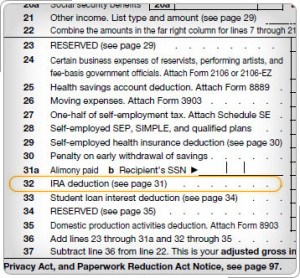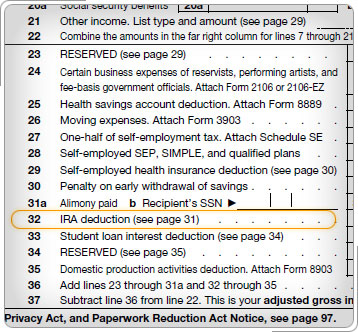 Generally, you can contribute up to $5,000 to an IRA in 2011 ($6,000 if you’ll be age 50 or older by the end of the year), as long as you have taxable compensation at least equal to the amount of your IRA contribution. But what if you have little or no taxable compensation for the year? The spousal IRA rule may help. If you’re married, file a joint federal income tax return, and earn less than your spouse, the amount you can contribute to an IRA is based on the combined compensation of you and your spouse.
Generally, you can contribute up to $5,000 to an IRA in 2011 ($6,000 if you’ll be age 50 or older by the end of the year), as long as you have taxable compensation at least equal to the amount of your IRA contribution. But what if you have little or no taxable compensation for the year? The spousal IRA rule may help. If you’re married, file a joint federal income tax return, and earn less than your spouse, the amount you can contribute to an IRA is based on the combined compensation of you and your spouse.
How it works
The rule is especially helpful if one spouse has little or no compensation. For example, Mary (age 45) and Joe (age 50) are married and file a joint return for 2011. Mary earned $100,000 in 2011 and Joe, a stay-at-home dad, earned nothing for the year. Mary contributes $5,000 to her IRAs for 2011. Even though Joe has no earnings, he can still contribute up to $6,000 to his IRAs for 2011, because Joe and Mary’s combined compensation is at least $11,000.
It gets just a little more complicated if your combined compensation is less than the maximum IRA contribution allowed. Assume Nicole earns $4,000 in 2011, and Jack earns $2,000, for total compensation of $6,000. If Nicole makes no contribution at all to her IRAs in 2011, Jack can contribute up to $5,000 to his IRA ($6,000 if he’s 50 or older). If Nicole contributes $4,000 to her IRAs for 2011, then Jack can contribute up to $2,000 to his IRA. Note that the spousal IRA rule applies only to the spouse with the lesser amount of compensation. In the previous example, the maximum amount that Nicole (the higher earning spouse) can contribute to her IRAs is $4,000, because she’s not entitled to take Jack’s earnings into account.
Here’s the actual contribution formula, as stated by the IRS: The spouse with the lesser amount of taxable compensation can contribute the smaller of the following two amounts:
- $5,000 ($6,000 if age 50 or older)
- The total amount the couple includes in gross income for the year, reduced by the amount the higher earning spouse contributes to his or her own IRAs (traditional or Roth) for that year
Source of funds
The spousal IRA rule only determines how much you can contribute. It doesn’t matter where the money you use to fund your IRA actually comes from. For instance, in the first example, Mary earned $100,000 and Joe earned nothing in 2011. But Joe could still contribute up to $6,000 to his IRA because of the spousal IRA rule. It doesn’t matter if the money Joe actually uses to fund his IRA comes from Mary, from savings, from a gift Joe receives, or from any other particular source. The spousal IRA rule doesn’t require you to track the source of your contribution.
Impact on other IRA rules
The spousal IRA rule doesn’t change any of the other rules that generally apply to IRAs. You can contribute to a traditional IRA, to a Roth IRA, or both. However, you can’t make regular contributions to a traditional IRA for the year you turn 70½ or thereafter. And your contributions to a traditional IRA are deductible only if neither you nor your spouse is covered by an employer retirement plan or, if either of you is covered by a plan, your combined income is within certain limits.
If you aren’t eligible to make deductible contributions to a traditional IRA because you and your spouse earned too much, you can make nondeductible contributions instead. However, you may be better off contributing to a Roth IRA (if you qualify) instead of making nondeductible contributions to a traditional IRA.
Your ability to make annual contributions to a Roth IRA may also be limited, or eliminated, depending on the amount of your combined income. If you’re eligible, though, you can contribute to a Roth IRA at any age–the 70½ rule doesn’t apply. And it doesn’t matter if you or your spouse is covered by an employer plan.
|
|
| Investment Advisor Representative: Cambridge Investment Research Advisors, Inc., a Registered Investment Advisor. Registered Representative: Securities offered through Cambridge Investment Research Inc., a Broker/Dealer, Member FINRA/SIPC. Cambridge and Affinity Wealth Advisors are not affiliated. |
| Prepared by Broadridge Investor Communication Solutions, Inc. Copyright 2011. |



